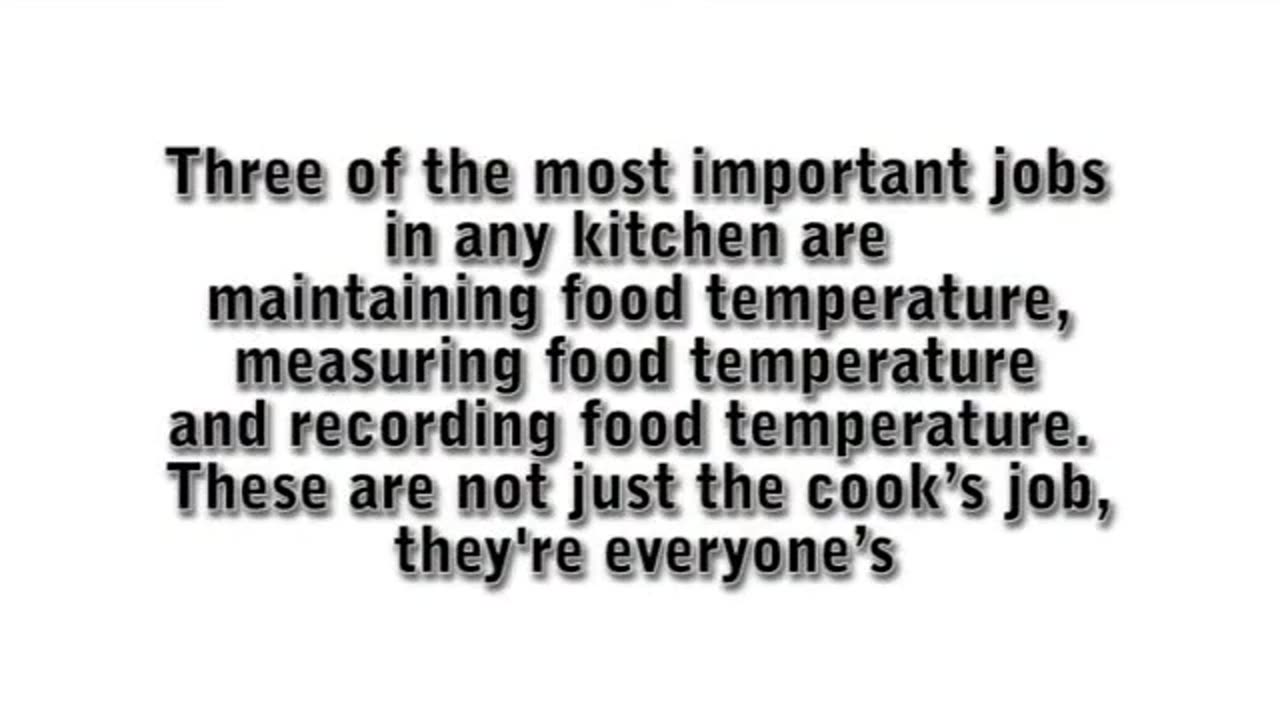Premium Only Content

Food Handler Training Course_ Part 4
### **Food Handler Training Course (Part 4) – Safe Food Storage**
Proper food storage is essential to maintaining food safety, preserving food quality, and preventing contamination. As a food handler, understanding safe storage practices helps protect customers from foodborne illnesses and ensures compliance with food safety regulations.
---
### **Objectives of Part 4**
1. Learn the principles of proper food storage.
2. Understand how to prevent contamination in storage areas.
3. Recognize best practices for organizing and maintaining storage spaces.
---
### **Importance of Safe Food Storage**
1. **Prevents Foodborne Illness:**
- Proper storage reduces the risk of bacterial growth and contamination.
2. **Preserves Food Quality:**
- Protects food from spoilage and maintains freshness.
3. **Complies with Regulations:**
- Adheres to food safety laws and guidelines, preventing penalties or closures.
---
### **Key Food Storage Principles**
#### **1. Temperature Control**
- Store food at the correct temperatures to prevent spoilage and bacterial growth:
- **Refrigerated Foods:** 0°C to 5°C (32°F to 41°F).
- **Frozen Foods:** -18°C (0°F) or lower.
- **Dry Foods:** 10°C to 21°C (50°F to 70°F) in a cool, dry area.
#### **2. FIFO System (First In, First Out)**
- Rotate stock to use older products first and reduce waste.
#### **3. Labeling and Dating**
- Clearly label all food items with their contents and the date of preparation or receipt.
- Include expiration dates to ensure foods are used within their safe timeframes.
#### **4. Proper Organization**
- Store food in a clean, organized manner to prevent cross-contamination.
- Use separate storage areas for raw and ready-to-eat foods.
---
### **Storage Best Practices**
#### **1. Refrigeration**
- Keep perishable items in the refrigerator at or below 5°C (41°F).
- Store raw meats, poultry, and seafood on the bottom shelves to prevent drips onto other foods.
- Avoid overloading the fridge to allow proper air circulation.
#### **2. Freezing**
- Freeze food immediately if it will not be used within a few days.
- Wrap items tightly to prevent freezer burn.
- Defrost frozen foods in the refrigerator, cold water, or microwave—not at room temperature.
#### **3. Dry Storage**
- Keep dry foods in sealed, labeled containers.
- Store items off the floor and away from walls to prevent pest infestations.
- Check for signs of spoilage or damage, such as bulging cans or torn packaging.
---
### **Preventing Contamination in Storage Areas**
#### **1. Physical Contamination**
- Use clean, food-safe containers for all stored items.
- Keep storage areas free of dirt, debris, and broken equipment.
#### **2. Chemical Contamination**
- Store cleaning products and chemicals away from food storage areas.
- Use food-grade containers and wraps to avoid contamination.
#### **3. Biological Contamination**
- Regularly clean and sanitize storage areas, including shelves and bins.
- Ensure proper temperature control to prevent bacterial growth.
---
### **Common Food Storage Mistakes to Avoid**
1. **Storing Raw and Cooked Foods Together:**
- Always separate raw foods from ready-to-eat items.
2. **Overpacking Refrigerators or Freezers:**
- Overloading can block airflow, leading to uneven cooling.
3. **Failing to Check Expiry Dates:**
- Regularly inspect stored foods and discard expired items.
4. **Leaving Foods Uncovered:**
- Cover all stored foods to protect them from contamination and drying out.
---
### **Examples of Safe Storage Practices**
**Scenario 1:** A chef receives a delivery of raw chicken, vegetables, and canned goods.
- **Safe Practice:** Store raw chicken on the bottom shelf of the refrigerator, vegetables on higher shelves, and canned goods in a cool, dry pantry.
**Scenario 2:** Leftover soup needs to be refrigerated.
- **Safe Practice:** Cool the soup quickly using shallow containers before placing it in the refrigerator.
---
### **Storage Checklist for Food Handlers**
- ✅ Maintain the correct storage temperatures for all food types.
- ✅ Label and date all stored foods.
- ✅ Use the FIFO system for inventory management.
- ✅ Keep storage areas clean and free from pests.
- ✅ Regularly inspect food for spoilage or contamination.
---
### **Tips for Success**
- Conduct regular training sessions on safe storage practices for all employees.
- Use thermometers to monitor refrigerator and freezer temperatures.
- Schedule routine cleaning and pest control for storage areas.
---
### **Conclusion**
Safe food storage is a cornerstone of food safety. By following best practices for temperature control, organization, and contamination prevention, food handlers can ensure the safety and quality of the food they serve.
---
Would you like to proceed to **Part 5: Cleaning and Sanitizing** or revisit another topic?
-
 6:54
6:54
HSESafetyInformation
9 months ago6 Must Try Breakfast recipes By Food Fusion
421 -
 56:25
56:25
ThisIsDeLaCruz
1 day ago $0.05 earnedHow Benson Boone’s Engineer Mixes From a Room You Never See
1.28K -
 6:10
6:10
Blabbering Collector
12 hours agoSaudi Arabia To Buy Warner Bros, Daniel Radcliffe Comments On HBO Harry Potter
1.73K1 -
 LIVE
LIVE
Lofi Girl
3 years agolofi hip hop radio 📚 - beats to relax/study to
246 watching -
 36:57
36:57
The Pascal Show
1 day ago $0.51 earned'THERE'S NOTHING TO HIDE?!' Trump SUDDENLY Urges House Republicans To Vote Release Epstein Files
1.87K -
 2:50:17
2:50:17
FreshandFit
13 hours agoClavicular Rates The Entire Panel’s Looks & They Get TRIGGERED
291K105 -
 2:22:44
2:22:44
Badlands Media
14 hours agoDevolution Power Hour Ep. 408: Immigration Panic, Epstein Optics & the Narrative Unraveling
100K24 -
 2:06:57
2:06:57
Inverted World Live
8 hours agoBigfoot in Idaho & Insect-Based Bioweapons | Ep. 144
90.3K5 -
 4:02:49
4:02:49
Akademiks
6 hours agoMeg Thee Stallion Back LYING again? Offset vs Finesse2x. 6ix9ine house robbed.. HERES WHO DID IT
40.2K2 -
 2:57:51
2:57:51
TimcastIRL
8 hours agoGOP Rep Threatens Hillary Clinton With CRIMINAL CHARGES Over Epstein | Timcast IRL
263K107